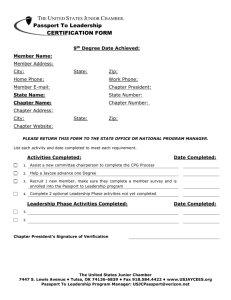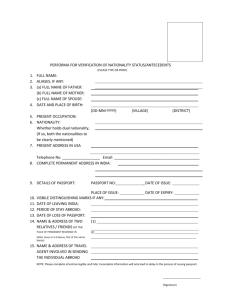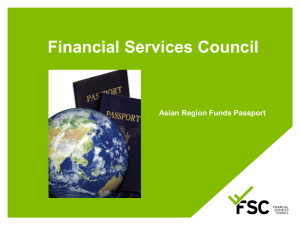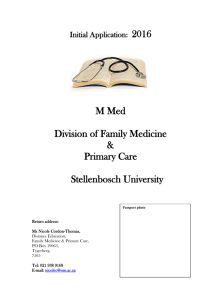5. Issuing new or replacement plant passports for `Protected Zone`
advertisement
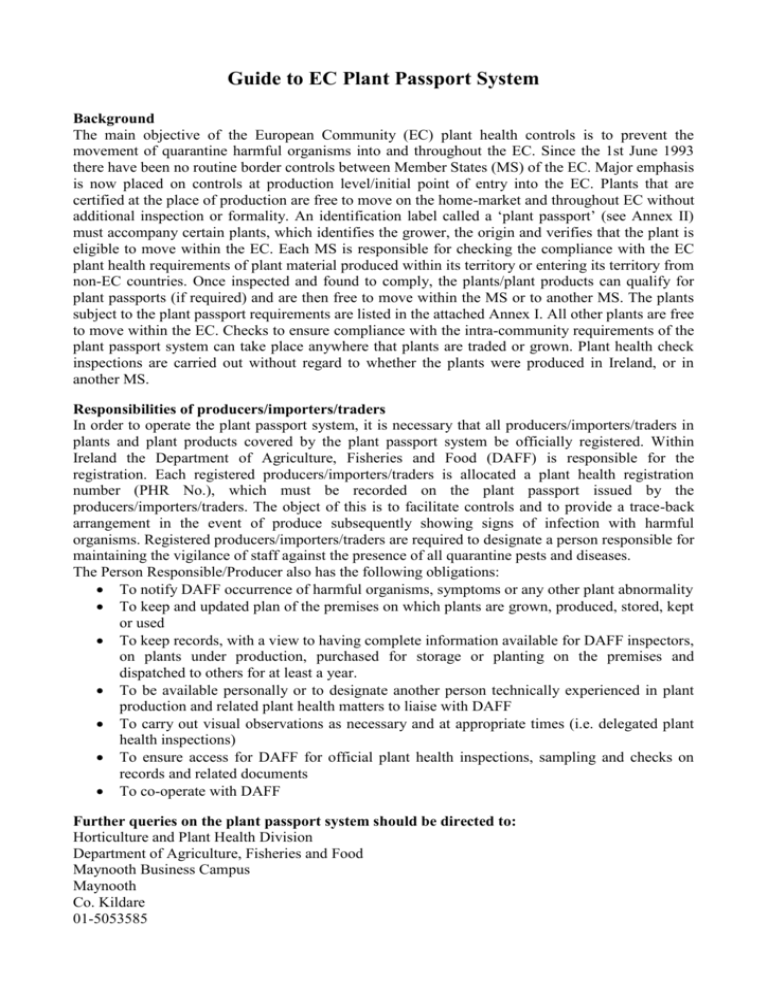
Guide to EC Plant Passport System Background The main objective of the European Community (EC) plant health controls is to prevent the movement of quarantine harmful organisms into and throughout the EC. Since the 1st June 1993 there have been no routine border controls between Member States (MS) of the EC. Major emphasis is now placed on controls at production level/initial point of entry into the EC. Plants that are certified at the place of production are free to move on the home-market and throughout EC without additional inspection or formality. An identification label called a ‘plant passport’ (see Annex II) must accompany certain plants, which identifies the grower, the origin and verifies that the plant is eligible to move within the EC. Each MS is responsible for checking the compliance with the EC plant health requirements of plant material produced within its territory or entering its territory from non-EC countries. Once inspected and found to comply, the plants/plant products can qualify for plant passports (if required) and are then free to move within the MS or to another MS. The plants subject to the plant passport requirements are listed in the attached Annex I. All other plants are free to move within the EC. Checks to ensure compliance with the intra-community requirements of the plant passport system can take place anywhere that plants are traded or grown. Plant health check inspections are carried out without regard to whether the plants were produced in Ireland, or in another MS. Responsibilities of producers/importers/traders In order to operate the plant passport system, it is necessary that all producers/importers/traders in plants and plant products covered by the plant passport system be officially registered. Within Ireland the Department of Agriculture, Fisheries and Food (DAFF) is responsible for the registration. Each registered producers/importers/traders is allocated a plant health registration number (PHR No.), which must be recorded on the plant passport issued by the producers/importers/traders. The object of this is to facilitate controls and to provide a trace-back arrangement in the event of produce subsequently showing signs of infection with harmful organisms. Registered producers/importers/traders are required to designate a person responsible for maintaining the vigilance of staff against the presence of all quarantine pests and diseases. The Person Responsible/Producer also has the following obligations: To notify DAFF occurrence of harmful organisms, symptoms or any other plant abnormality To keep and updated plan of the premises on which plants are grown, produced, stored, kept or used To keep records, with a view to having complete information available for DAFF inspectors, on plants under production, purchased for storage or planting on the premises and dispatched to others for at least a year. To be available personally or to designate another person technically experienced in plant production and related plant health matters to liaise with DAFF To carry out visual observations as necessary and at appropriate times (i.e. delegated plant health inspections) To ensure access for DAFF for official plant health inspections, sampling and checks on records and related documents To co-operate with DAFF Further queries on the plant passport system should be directed to: Horticulture and Plant Health Division Department of Agriculture, Fisheries and Food Maynooth Business Campus Maynooth Co. Kildare 01-5053585 Annex I PLANTS SUBJECT TO THE PLANT PASSPORT REQUIREMENT 1. FIREBLIGHT HOSTS Amelanchier (Serviceberry) Chaenomeles (Quince) Cotoneaster (No common name known) Crataegus (Whitethorn, Hawthorn) Cydonia (Quince) Eriobotrya (Loquat) Malus (Apple, Crab apple - including ornamental), Mespilus (Medlar) Pyracantha (Firethorn) Pyrus (Pear - including ornamental) Sorbus (other than S. intermedia) (Rowan, Mountain Ash, Whitebeam), Photinia davidiana (Photinia) 2. CONIFERS Abies (Fir) Larix (Larch) Picea (Spruce) Pinus (Pine) Pseudotsuga (Douglas Fir) 3. POPLARS Populus Ireland is a Protected Zone* in respect of Erwinia amylovora, the organism, which causes fireblight disease. The code to be used is ZP (b) 2 Ireland is a Protected Zone in respect of eleven named harmful organisms of the coniferous species. The code to be used is ZP Conf. Ireland is a Protected Zone in respect of Hypoxylon mammatum, which causes Hypoxylon canker The code to be used is ZP (c) 3 4. PRUNUS SPECIES Prunus (other than P. laurocerasus and P. lusitanica) – (plums, cherries, almonds, apricots, blackthorn, damson etc.) Subject to the plant passport but not to a Protected Zone requirement. 5. PHYTOPHTHORA RAMORUM HOSTS Camellia spp. Rhododendron spp. (other than R. simsii) Viburnum spp. 6. POTATO SPINDLE TUBER VIROID HOSTS (PSTV) Brugmansia spp. Solanum jasminoides Subject to the plant passport but not to a Protected Zone requirement. Subject to the plant passport but not to a Protected Zone requirement. 7. PALM PLANTS Plants (other than fruit and seeds) having a diameter of the stem at the base of over 5 cm of: Areca catechu, Arenga pinnata Borassus flabellifer Calamus merillii Caryota maxima Caryota cumingii Cocos nucifera Corypha gebanga Corypha elata Elaeis guineensis Livistonadecipiens Metroxylon sagu Oreodoxa regia Phoenix canariensis Phoenix dactylifera Phoenix theophrast Phoenix sylvestris Sabalumbraculifera Trachycarpus fortunei Washingtonia spp. Subject to the plant passport but not to a Protected Zone requirement. 8. OTHERS Castanea spp. Citrus spp. Humulus lupulus spp. Fortunella spp. Poncirus spp. Solanum (Plants, including hybrids, of stolon or tuber-forming species) Vitis spp. Subject to the plant passport but not to a Protected Zone requirement. *PROTECTED ZONES These are areas in the EU in which certain quarantine organisms are not endemic or established, despite favorable conditions for them to establish there. When ZP, plus the relevant code, is shown on the plant passport, this indicates that the special requirements listed in the Plant Health Directive in respect of the movement of relevant material into, and within, protected zones have been complied with. If this designation is not shown, the material is not eligible to move into, or within, such zones. Plants traded among professional plant producers The following plants require a plant passport when produced by producers whose production and sale is authorised to persons professionally engaged in plant production, other than those plants, plant products and other objects which are prepared and ready for sale to the final consumer, and for which it is ensured by the responsible official bodies of the Member States, that the production thereof is clearly separate from that of other products 1. Plants intended for planting other than seeds of the genera: Abies Mill., Apium graveolens L., Argyranthemum spp., Aster spp., Begonia L, Brassica spp., Castanea Mill., Cucumis spp., Dendranthema (DC) Des Moul., Dianthus L. and hybrids, Euphorbia pulcherrima, Exacum spp., Ficus L ,Fragaria L., Gerbera Cass., Gypsophila L., Hibiscus L., all varieties of New Guinea hybrids of Impatiens L., Lactuca spp., Larix Mill., Leucanthemum L., Lupinus L., Pelargonium l'Hérit. ex Ait., Picea A. Dietr., Pinus L., Platanus L., Populus L., Prunus laurocerasus L., Prunus lusitanica L., Pseudotsuga Carr., Quercus L., Rubus L., Spinacia L., Tanacetum L., Tsuga Carr. and Verbena L. 2. Other plants of herbaceous species, other than plants of the family Gramineae, intended for planting, and other than bulbs, corms, rhizomes, seeds and tubers. 3. Plants of Solanaceae, other that seeds. 4. Plants of Araceae, Marantaceae, Musaceae, Persea spp. and Strelitziaceae, rooted or with growing medium attached or associated 5. Seeds and bulbs of Allium ascalonicum L., Allium cepa L. and Allium schoenoprasum L. intended for planting and plants of Allium porrum L. intended for planting, Seeds of Medicago sativa L., Certified seeds of Helianthus annuus L., Lycopersicum lycopersicum (L.) Karsten ex Farw. and Phaseolus L. 6. Bulbs and corms of: Camassia Lindl., Chionodoxa Boiss., Crocus flavus Weston ‘Golden Yellow’, Galanthus L., Galtonia candicans (Baker) Decne., miniature cultivars and their hybrids of the genus Gladiolus Tourn. ex L., such as Gladiolus callianthus Marais, Gladiolus colvillei Sweet, Gladiolus nanus hort., Gladiolus ramosus hort. and Gladiolus tubergenii hort., Hyacinthus L., Iris L., Ismene Herbert, Muscari Miller, Narcissus L., Orinthogalum L., Puschkinia Adams, Scilla L. Tigridia Juss. and Tulipa L. Annex II The Plant Passport A. Types of plant passport The plant passport may be a label or label and an accompanying document (often part of a delivery note or similar trade document) attached to the plants, their packaging or the vehicle carrying the plants. If this contains all the information contained at B. below (also described in Annex of Commission Directive 92/105/EEC) it is known as a full plant passport. The plant passport may also be divided between one or more labels (the plant passport labels) containing all the information contained at B. below, attached to units of the consignment, and an accompanying document, which again can be a delivery note or similar document. The accompanying document may refer to labels from more than one origin or plant type. Using labels attached to units of the consignment could make it easier for the customer to sell on part of the consignment, because a new replacement plant passport would not then always be necessary. B. Information to appear on the plant passport The information that has to be carried on the plant passport is as follows: 1. 2. 3. 4. 5. 6. 7. 8. EC plant passport Indication of EC Member State code Indication of responsible official body or its distinguishing code Registration number Individual serial or batch number Botanical name Quantity The distinctive marking ‘ZP’ for the territorial validity of the plant passport, and where appropriate, the name of the protected zone(s) for which the product is qualified 9. The distinctive marking ‘RP’ in case of replacement of a plant passport and, where appropriate, the code of the originally registered producer or importer 10. Where appropriate, the name of the country of origin or consignor country, for third country products The following points are offered for guidance only. We cannot guarantee that other Member States will use the same interpretation. Nurseries planning to send consignments to other Member States should be advised to check with their customers whether there are likely to be any problems with their proposed passports. Plant passport items 1-4 - registration details These must appear on the full plant passport. The four items can be run together as follows: 'EC/Plant Passport IRL/DAFF/1234'. The four-digit number is the PHR number of the registered producer/importer/trader. The prefix IRL/IE distinguishes producers in Ireland from those in other parts of the EU, who may have the same number. Plant passport item 5 – individual serial or batch number This must appear on the full plant passport, or on all parts of a split plant passport. It will be used to relate the different parts of a split plant passport and to identify intercepted consignments more closely than would be possible from the PHR number alone. Considerable flexibility should be shown in interpreting this requirement. In some circumstances a year of production would be adequate. In other cases an invoice number or unique label number would be appropriate. There are advantages to the grower being specific in identifying the week or batch number. If quarantine pests are identified on a consignment from the nursery, it may be possible to confine movement restrictions and visits to other customers more narrowly, if the likely origin of the pest can be pinpointed from the records using a batch or week number. Plant passport item 6 - botanical name This must appear on the full plant passport, or on the accompanying document of the split passport. The degree of detail required will depend upon the type of plants being traded. In some cases a genus name will be adequate, or a genus and variety. For brassicas, for example, 'Brassica cabbage – cv. ‘January King' would be adequate. Plant passport item 7 - quantity This is required on the full plant passport, or on the accompanying document of the split plant passport. Any sensible measure of quantity should be acceptable. Where a full plant passport is used, the quantity should refer to the quantity covered by that plant passport. Take for example, a consignment comprising twenty boxes each containing 1000 cuttings. If each box has a full passport, the passport should refer to the quantity of cuttings in one box, not the quantity in the whole consignment, i.e. '1000 cuttings'. If the consignment is covered by a split passport, the accompanying document should refer to the total quantity of cuttings in the consignment, and the number of boxes or other units covered by individual plant passport labels: in this example '20,000 cuttings in 20 boxes'. Plant passport item 8 - protected zone eligibility This is required on the full passport or on the accompanying document, only when the plants are eligible to move into or within a protected zone. It must be indicated by the letters 'ZP' (zona protecta) plus the code for the protected zone. For example for the Fireblight protected zone the plant passport could read 'ZP –IRL (code for the relevant PZ, in this case the entire territory of Ireland). More widely used are the item numbers in the Protected Zone Directive (92/76/EEC as amended), e.g. for the Fireblight protected zone this would read 'ZP -b2'. Plant passport item 9 – replacement plant passport mark This is required on the full plant passport or on the accompanying document where appropriate. The full code of the original producer should be printed after the letters RP, for example 'RP IRL/DAFF/1234' for material originating with the grower whose PHR number is 1234. See also additional note below regarding replacement of plant passport. Passport item 10 - country of origin The full name of the country of origin is required on the full plant passport or on the accompanying document for plants imported from third countries, and should be reproduced on any replacement plant passport. C. Replacement of plant passports When plants are received with a plant passport, and must be despatched again with a plant passport, there are several different ways in which that plant passport requirement can be fulfilled. The allowable options depend upon what has happened to those plants between receipt and dispatch, what sort of plant passport was on them when they came, and where they are going. 1. Trading fully plant passported plants Plants which are received with a full passport, and are not grown on* may be traded on with the same full passport, provided the unit to which the passport relates is not broken down or added to. The trader does not need to be authorised to do this, because no passport is issued. The trader bears the same responsibility as anyone else to notify the occurrence of quarantine pests on that plant passported material and to record the plant passport details of the plants traded. 2. Issuing replacement passports Plants which are received with a passport of any sort, and which have not been grown on* may be traded on with a replacement plant passport. Such traders must be authorised to issue plant passports, and must keep the original full plant passport or its details or accompanying document (or details) for at least a year. 3. Issuing new passports - plants going to commercial growers If the plants are going to a commercial grower, and they have been grown on* the nursery must carry out a thorough inspection to satisfy themselves that the plants are free from quarantine organisms. They can then issue a new plant passport, bearing only their own registration number. The nursery must be authorised to issue plant passports, and must keep the original full plant passport or accompanying document for at least a year. If the plants have not been grown on*, it is possible for trade within Ireland, for the nursery to issue their own plant passport after thoroughly inspecting the plant material and satisfying themselves that no quarantine pests or diseases are present providing their recording system can identify the material to its original source. 4. Trading plant passport labelled plants Plants, which are received with plant passport labels attached and are not grown on*, may be traded on with the same passport labels, and an accompanying document issued by the trader. This may be done even if the consignment covered by the accompanying document has been broken down, provided that the individual units to which the passport labels are attached are not broken down or added to. The accompanying document will be part of the plant passport, will refer to the original plant passport labels, which are present on the plants, and will reproduce the information received on the accompanying document from the supplier. The trader must be authorised to issue plant passports, and is obliged to keep the original accompanying document for at least a year. 5. Issuing new or replacement plant passports for ‘Protected Zone’ plants The ‘ZP’ marking cannot be added to the plant passport unless the plants have come from a nursery which fully meets the ‘protected zone’ requirement and ZP details were on the original plant passport or until they have been on the buyer’s nursery long enough to meet ZP requirements. *Growing On can be defined as follows: Growing plants for sale or distribution or maintaining material where its plant health status could change Nurseries may consider their plants to have been grown on if they have been: i) In active growth under protection for at least two weeks, or ii) In active growth outside for at least four weeks Nurseries must consider their plants to have been grown on if they have been: i) Potted, repotted, grafted or rooted or ii) In active growth under protection for at least four weeks, or iii) In active growth outside for at least twelve weeks, or iv) Subject to high risk of infestation by a quarantine organism (e.g. grown on a premises subject to Statutory Notice) D. Records to be kept of plant passports issued Records or copies of all plant passports issued must be kept for a year and made available to DAFF on request, along with the reports from the inspections carried out by the ‘Responsible Person’ before the plant passports were issued. These records must be readily accessible either as part of the regular nursery assessment or at short notice to enable DAFF to trace quickly the likely source of a quarantine pest intercepted on a consignment. E. Retention of plant passports by recipients 1. General requirement to retain passports There is a general obligation on all those who receive plant passported material to remove the plant passport and retain it for a year. This does not apply if the plant passport is to be passed on directly to the next customer in the marketing chain although the seller should keep a record of the passport details. For split plant passports only the accompanying document needs to be retained. 2. Retention of Invoices It will not be acceptable for plant passport information to appear on the invoice alone. However retention of an invoice carrying an exact copy of the plant passport details from the delivery note will be acceptable as an alternative to keeping the delivery note itself or the plant passport label. The invoice must contain all plant passport information and be retained for 1 year. 3. Retention of alternative records in lieu of plant passports Likewise where a complete passport is in the form of an adhesive label attached to a plant tray or other container or is of a similar form which makes it impractical to retain the plant passport itself, then the recipient may keep a manual or computer record of the details in lieu of the plant passport itself. The record must contain all plant passport information and be retained for 1 year. It must be easily retrieved to allow traceback, for inspection as part of regular plant health inspections and be freely available to DAFF at all times. F. Example of what a plant passport might look like EC plant passport/IRL/DAFF/ 1234/ wk32 qty1 plant ZP b2 Cotoneaster ‘Hybridus Pendulus’
